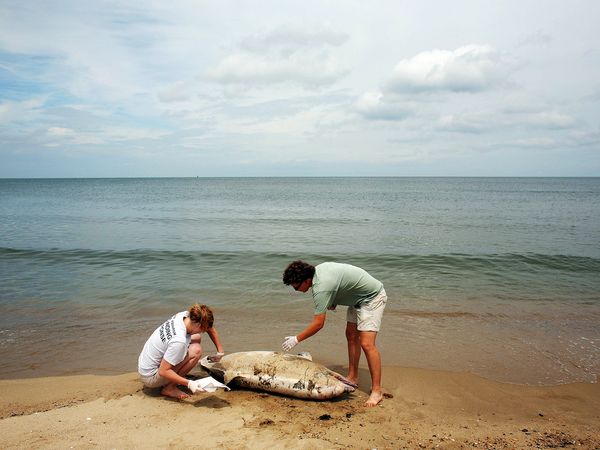
The high death toll, covering an area that stretches from New York to Virginia, has been labeled an "unusual mortality event," and the U.S. National Oceanic and Atmospheric Administration (NOAA) has experts scrambling to figure out what's going on.
Based on the rapid increase in dead bodies washing ashore, and the broad geographic reach, "an infectious pathogen is at the top of the list of potential causes," according to NOAA's website.
"We realize that people are very concerned and anxious to learn what we know about the dolphin deaths that have been occurring along the mid-Atlantic coast over the past few weeks," Maggie Mooney-Seus, a spokesperson for NOAA Fisheries, told National Geographic by email.
Experts have collected quite a bit of information from various animals' blood and tissue samples, which they're testing for a variety of toxins, biotoxins, bacteria, fungi, and viruses, she said.
Several of the dead dolphins have tested positive for morbillivirus, a measles-like, airborne virus that's often fatal in dolphins. A morbillivirus epidemic hit East Coast bottlenose dolphins in 1987 and 1988, wiping out at least 900 animals and striking a major blow to that population of migratory mammals. However, there's no definitive cause yet, and some of the tests take weeks to complete, Mooney-Seus noted.
"We share the public's desire to get answers to what is causing this and are working as quickly as we can to get those answers."
Determining a Cause of Death
The spike follows a general trend in unusual mortality events that have occurred in recent decades in the United States.
In the northern Gulf of Mexico, for instance, where there's an ongoing unusual mortality event, over a thousand dolphins and whales have washed up dead since February 2010. (Also see "Dolphin-Baby Die-Off in Gulf Puzzles Scientists [2011].")
The "concern is we're doing more and more to protect dolphins from harm, yet dolphin strandings are on the rise," Matthew Huelsenbeck, a marine scientist at the nonprofit Oceana, said earlier this month.
"No one seems to have a solid grasp as to what's going on."
But many are working to find out. For example, NOAA has a stranding network of experts who report and collect the corpses of recently deceased dolphins in an effort to determine causes of death.
A corpse is first taken into the lab for evaluation and basic triage to see if it has any visible marks that may point to the cause of its demise. Next, a tissue sample is taken and tested for viruses, which could identify a direct cause.
Then there's a longer-term investigation that involves testing blubber and organs, such as kidneys, for traces of heavy metals. Studies have shown that stranded dolphins have heavy metals in their systems.
"Dolphins are some of the most toxic animals on the planet, and it makes their immune system compromised because they're carrying so many heavy metals and toxins that accumulate in the food web," noted Huelsenbeck. (Also see "New Diseases, Toxins Harming Marine Life.")
He also noted that the dead bodies that wash ashore are only a small percentage of the actual death toll. For instance, many dolphin corpses decompose at sea or are eaten by predators.
"For a lot of these animals," he said, "their story will never be told."



Reader Comments
to our Newsletter